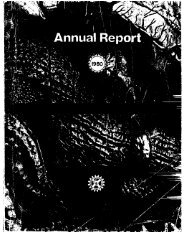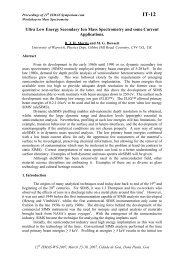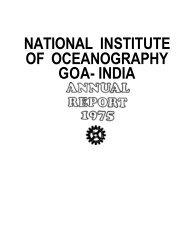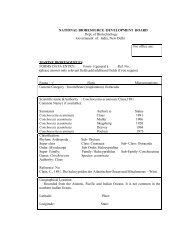CFD for Ballast Water & Bio-fouling Management
CFD for Ballast Water & Bio-fouling Management
CFD for Ballast Water & Bio-fouling Management
You also want an ePaper? Increase the reach of your titles
YUMPU automatically turns print PDFs into web optimized ePapers that Google loves.
<strong>CFD</strong> <strong>for</strong> <strong>Ballast</strong> <strong>Water</strong> & <strong>Bio</strong>-<strong>fouling</strong><br />
<strong>Management</strong><br />
Vivek V. Ranade<br />
Catalysis, Reactors & Separation Unit (CReST)<br />
Chemical Engineering Division<br />
National Chemical Laboratory<br />
Pune 411008<br />
vv.ranade@ncl.res.in
OUTLINE<br />
• <strong>Ballast</strong> <strong>Water</strong> & <strong>Bio</strong>-<strong>fouling</strong> <strong>Management</strong><br />
– Key issues<br />
• Computational Fluid Dynamics<br />
– What is <strong>CFD</strong>?<br />
– Methodology<br />
– Sample applications<br />
• Closure<br />
<strong>CFD</strong> <strong>for</strong> <strong>Ballast</strong> <strong>Water</strong> & <strong>Bio</strong>-<strong>fouling</strong> <strong>Management</strong>
BALLAST WATER/ BIO-FOULING<br />
• Filling/ draining: water hammer<br />
• Sloshing<br />
• Cleaning: high velocity jets<br />
• Mixing/ g exchange/ g ballast water treatment<br />
• Corrosion<br />
– Microbial<br />
– Flow assisted<br />
• Film <strong>for</strong>mation: stability & break-up<br />
• Valves/ diodes/ piping circuit<br />
• Handling large quantities of water/ complex protocols<br />
<strong>CFD</strong> <strong>for</strong> <strong>Ballast</strong> <strong>Water</strong> & <strong>Bio</strong>-<strong>fouling</strong> <strong>Management</strong>
BALLAST WATER EXCHANGE<br />
• Replace coastal water with open ocean water during<br />
a voyage<br />
– Emptying and refilling ballast tanks (sequential exchange)<br />
– Flow-through dilution/ continuous exchange<br />
• Concerns about<br />
– <strong>Bio</strong>logical effectiveness<br />
– Ship safety and operational issues<br />
• Excess bending moment/ shear stress, propeller immersion,<br />
minimum <strong>for</strong>ward draft, sloshing … <strong>for</strong> sequential exchange<br />
• Flushing by fresh water, stratification, over pressurization … <strong>for</strong><br />
continuous exchange<br />
<strong>CFD</strong> <strong>for</strong> <strong>Ballast</strong> <strong>Water</strong> & <strong>Bio</strong>-<strong>fouling</strong> <strong>Management</strong>
SLOSHING<br />
From Lee et al., Ocean Engineering 34 (2007) 3–9<br />
<strong>CFD</strong> <strong>for</strong> <strong>Ballast</strong> <strong>Water</strong> & <strong>Bio</strong>-<strong>fouling</strong> <strong>Management</strong>
• Use of <strong>Bio</strong>cides<br />
WATER TREATMENT<br />
– Mixing of very small quantities in huge volume<br />
• Heat Treatment<br />
• UV<br />
• Ultrasonic Cavitation<br />
• Hydrodynamic Cavitation<br />
Exposure time distribution<br />
Pressure profiles, mixing<br />
<strong>CFD</strong> <strong>for</strong> <strong>Ballast</strong> <strong>Water</strong> & <strong>Bio</strong>-<strong>fouling</strong> <strong>Management</strong>
BALLAST WATER/ BIO-FOULING<br />
• Filling/ draining: water hammer<br />
• Sloshing<br />
• Cleaning: high velocity jets<br />
• Mixing/ g exchange/ g ballast water treatment<br />
• Corrosion<br />
– Microbial<br />
– Flow assisted<br />
• Film <strong>for</strong>mation: stability & break-up<br />
• Valves/ diodes/ piping circuit<br />
• Handling large quantities of water/ complex protocols<br />
<strong>CFD</strong> <strong>for</strong> <strong>Ballast</strong> <strong>Water</strong> & <strong>Bio</strong>-<strong>fouling</strong> <strong>Management</strong>
BALLAST WATER/ BIO-FOULING<br />
• Detailed Modeling of Fluid Dynamics is Essential<br />
• Conventional Methods<br />
– Analytical fluid mechanics<br />
• Restricted to very simple flows<br />
– Scale models<br />
• Restricted validity/ difficult to extrapolate<br />
• Time consuming/ expensive<br />
• COMPUTATIONAL FLUID DYNAMICS (<strong>CFD</strong>)<br />
<strong>CFD</strong> <strong>for</strong> <strong>Ballast</strong> <strong>Water</strong> & <strong>Bio</strong>-<strong>fouling</strong> <strong>Management</strong>
WHAT IS <strong>CFD</strong>?<br />
• Solution of Mass, Momentum and Energy Balances on Digital<br />
Computers<br />
• Major Features<br />
– No restrictive assumptions / approximations<br />
– Can handle complex geometry of industrial process equipment<br />
– Can incorporate variety of processes simultaneously<br />
• Can lead to:<br />
– Accurate insight of underlying fluid dynamics<br />
– A bridge between theory and experiments<br />
– Process data which can not be obtained from experiments<br />
<strong>CFD</strong> <strong>for</strong> <strong>Ballast</strong> <strong>Water</strong> & <strong>Bio</strong>-<strong>fouling</strong> <strong>Management</strong>
COMPUTATIONAL FLOW MODELING<br />
• Enhanced understanding of theory through numerical<br />
experiments<br />
– Bridge between theory and experiments<br />
• Detailed analysis at early stage in design cycle <strong>for</strong> less money,<br />
less risk and less time<br />
• May provide data which is not possible to obtain experimentally<br />
– High pressure/ temperatures<br />
– Corrosive conditions<br />
• Screening of alternative design configurations<br />
• Sounds too good to be true ! Is there any catch some where?<br />
<strong>CFD</strong> <strong>for</strong> <strong>Ballast</strong> <strong>Water</strong> & <strong>Bio</strong>-<strong>fouling</strong> <strong>Management</strong>
COMPUTATIONAL FLOW MODELING<br />
• Uncertainties / Limitations:<br />
– Inadequacies of the underlying mathematical model & input data<br />
• Turbulence<br />
• Multiphase flows<br />
• Complex Rheology<br />
• Chemical reactions<br />
– Inaccuracies of the numerical technique (discretisation and roundoff<br />
errors)<br />
– Computational constraints<br />
– Interpretation of results<br />
• Despite the Limitations, <strong>CFD</strong> has Enormous Potential !<br />
– Necessary to develop appropriate methodology to harness this<br />
potential<br />
<strong>CFD</strong> <strong>for</strong> <strong>Ballast</strong> <strong>Water</strong> & <strong>Bio</strong>-<strong>fouling</strong> <strong>Management</strong>
CReST @ NCL<br />
• Multi-scale Modeling Capabilities to Provide Complete<br />
Solutions <strong>for</strong> Reactor/ Product Engineering<br />
Simulation of Drop Impact on Flat Surface:<br />
Understanding wetting<br />
Separate model to<br />
simulate erosion of<br />
support hooks<br />
Top portion of industrial thermo-siphon loop<br />
reactor modeled using hybrid approach<br />
Simulation of Fluidized Bed Reactor:<br />
multi-scale approach<br />
<strong>CFD</strong> <strong>for</strong> <strong>Ballast</strong> <strong>Water</strong> & <strong>Bio</strong>-<strong>fouling</strong> <strong>Management</strong>
METHODOLOGY<br />
• Development & Creative Use of<br />
Computational Models <strong>for</strong> Better<br />
Reactor, Process & Product<br />
Engineering<br />
<strong>CFD</strong> <strong>for</strong> <strong>Ballast</strong> <strong>Water</strong> & <strong>Bio</strong>-<strong>fouling</strong> <strong>Management</strong>
• Optimizing <strong>Ballast</strong> <strong>Water</strong><br />
Exchange Strategies<br />
APPLICATIONS<br />
J-type side<br />
<strong>Ballast</strong> Tank<br />
• <strong>Ballast</strong> <strong>Water</strong> Treatment<br />
Technology<br />
– Based on hydrodynamic<br />
cavitation<br />
<strong>CFD</strong> <strong>for</strong> <strong>Ballast</strong> <strong>Water</strong> & <strong>Bio</strong>-<strong>fouling</strong> <strong>Management</strong><br />
• Modeling of cavitating flows<br />
• Devising effective<br />
cavitating it ti chamber h b f<strong>for</strong><br />
destruction of microbes<br />
• Adjust number density of<br />
cavities and intensity of<br />
collapse as per the<br />
requirements<br />
– Patented cavitating devices<br />
<strong>for</strong> water dis-infection
BALLAST WATER DISPOSAL<br />
• Flow-Through Exchange Method<br />
– 300% of a tank’s full capacity of clean water from the deep ocean<br />
must be pumped into each tank to achieve an acceptable 95%<br />
volumetric exchange.<br />
• Sequential q Exchange g ( (empty p y / refill) )<br />
– Involves emptying tanks of high-risk ballast water at sea be<strong>for</strong>e<br />
refilling them with clean water from the deep ocean.<br />
• Dilution Method<br />
– Tank is partially filled and filling deep ocean water will dilute to<br />
original ballast water to 5%<br />
• Exchange to take place no less than 200 nautical miles from<br />
coast & at water depth of at least 200 m<br />
<strong>CFD</strong> <strong>for</strong> <strong>Ballast</strong> <strong>Water</strong> & <strong>Bio</strong>-<strong>fouling</strong> <strong>Management</strong>
FLOW THROUGH EXCHANGE<br />
From Eames et al., Mar. Pollut. Bull. (2007), doi:10.1016/j.marpolbul.2007.10.032<br />
<strong>CFD</strong> <strong>for</strong> <strong>Ballast</strong> <strong>Water</strong> & <strong>Bio</strong>-<strong>fouling</strong> <strong>Management</strong>
TYPES OF BALLAST TANKS<br />
Regular<br />
Double Bottom tank<br />
Hopper pp Upper pp Wing g<br />
<strong>Ballast</strong> Tank<br />
J-type side<br />
<strong>Ballast</strong> Tank<br />
<strong>CFD</strong> <strong>for</strong> <strong>Ballast</strong> <strong>Water</strong> & <strong>Bio</strong>-<strong>fouling</strong> <strong>Management</strong>
DOUBLE BOTTOM BALLAST TANK<br />
Geometric Details :<br />
1. Volume of tank = 410 m3 2. Flow rate = 1000 m3 /hr<br />
9.12 m<br />
410 3<br />
3<br />
Tank volume m<br />
τ<br />
= = = 0.<br />
41hrs<br />
= 1476sec<br />
pumping rate 1000m<br />
hr<br />
<strong>CFD</strong> <strong>for</strong> <strong>Ballast</strong> <strong>Water</strong> & <strong>Bio</strong>-<strong>fouling</strong> <strong>Management</strong><br />
30 m<br />
1.5 m
Outlet-1<br />
inlet<br />
Single port<br />
PORT CONFIGURATIONS<br />
Outlet-2<br />
Outlet-1<br />
<strong>CFD</strong> <strong>for</strong> <strong>Ballast</strong> <strong>Water</strong> & <strong>Bio</strong>-<strong>fouling</strong> <strong>Management</strong>








